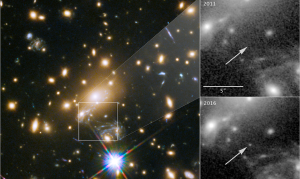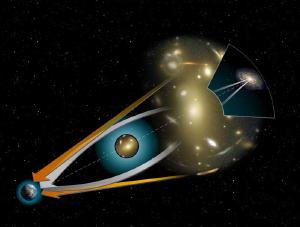Blog
The Invisible Star
10 April 2018
 NASA, ESA, and P. Kelly (University of Minnesota)
NASA, ESA, and P. Kelly (University of Minnesota)There’s a limit to how far into the cosmos we can see. One of the biggest limiting factors is simply the brightness of an object. The more distant an object, the dimmer the object will appear. Even if there is no gas or dust in the way, the brightness decreases proportional to the square of its distance. For example, if two stars are equally bright, and one is twice as far away as the other, we will observe four times the light from the closer star than we see from the distant star. Because of this, main sequence stars such as our Sun can only be observed out to a few hundred million light years. Galaxies can be seen from billions of light years away, as can brilliant supernovae, but not a simple star.
But sometimes fortune favors the fortunate. There is a way that gravity can make an object appear brighter than it actually is. Just as a telescope can magnify light of a distant object, so can a gravitational lens. Gravitational lensing occurs when light from a distant is deflected by the presence of mass along our line of sight. It was first observed by Arthur Eddington in 1919, and was the first validation of general relativity. As light is deflected around a galaxy or other mass, we see it coming from multiple directions. This means more light reaches us than normally would without lensing. So the star looks brighter than we’d expect.
 NASA
NASAThis particular star, informally known as Icarus, is behind a large cluster of galaxies called MACS J1149+2223, and while the mass of the cluster brightened the star a bit, it wasn’t enough to be easily seen by the Hubble Space Telescope. But then a star from the cluster happened to pass in front of the distant star. This created an effect known as an Einstein ring, where light from Icarus grazes the closer star and is focused in our direction. The result is a significant brightening of the star. The combination of gravitational lensing from the galaxy cluster and the Einstein ring made Icarus appear 2000 times brighter than it actually is, making it bright enough for Hubble to capture. It’s light traveled for 9 billion years to reach us, making it the most distant main sequence star we’ve ever observed.
Sadly, Icarus itself is long dead. Analysis of the light shows that Icarus was a blue supergiant, similar to the bright star Rigel in the constellation of Orion. These stars can be 10,000 times brighter than our Sun, but their brilliance comes at a cost. They typically only shine for a few million years before dying as a brilliant supernova. The flicker of Icarus captured by Hubble is a luminous echo of a star that died when the universe was only 4 billion years old. Long before our own Sun began to form.